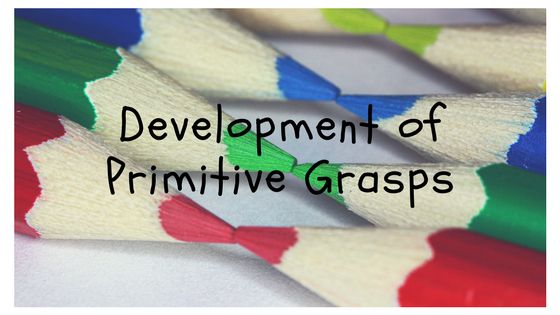Hey OTs (and anyone else interested in helping kids with handwriting!)
Let’s spend some time this week discussing the development of grasps, which are simply the ways we hold things in our hands. One of the first stages of a child’s development is the use of a palmar grasp, and this grasp is a building block for all other fine motor skills that come later. Also important at this stage is a baby’s ability to release from the palmar grasp.
In a palmar grasp, babies hold on object that is in their palm by wrapping their fingers down around it, without using their thumb. It is interesting to observe that a baby may crudely grasp a small object using his palm and all four fingers, even though the object could be grasped more efficiently with just two fingers or a finger and his palm. 
Sometimes a baby will be delayed in acquiring this grasp, or may have difficulty keeping object in his hand. Some activities to help promote gross grasp, grasp strength, and release include squeezing water from sponges at bath time, squeezing play-dough, scrunching up paper into balls, stacking blocks on top of one another, or throwing objects.
One interesting thing about the palmar grasp is that it’s actually a reflex – babies will close their hand on something placed in their palm reflexively. You might have noticed that this grasp is pretty strong, and babies can often support their own weight using this grasp. Just be careful – a baby can release suddenly without any reason! Don’t you love when a baby grasps your index finger with his palm and four fingers? It’s one of the cutest things a baby will do!
The palmar grasp is referred to as a crude grasp, and after this stage babies begin to develop more functional grasps, such as a cylindrical grasp, which begins to involve the movement of the wrist. This grasp is also called the barrel grasp, because it looks like the child’s fingers are in the shape of a barrel around whatever she is grasping.
In this grasp, a child can manipulate the object she is holding by using gross arm movements, but also slightly finer movement with the wrist. Little kids will often hold their crayons this way as they begin coloring and doodling. If you try writing with this grasp you will see that it doesn’t produce very legible writing, and your arm, wrist, and hand will tire quickly. Still, this grasp is an improvement over the reflexive, primitive palmar grasp, and it’s important that babies progress to more and more functional grasps.
If a child needs help developing a strong cylindrical grasp you may want to try one these activities which will help develop this grasp:
- Pushing or pulling toys
- ‘Row, row, row your boat’ – holding a broom stick
- Tug-of-war
- Tipping water from a cup or beaker, or pouring from one container into another
- Holding onto the rope of a swing
- Holding onto the handles of a tricycle or pedal car
The good news is that these are fun for kids! Come back next week for more on grasps, and tips to help children develop their grasps and handwriting.
-Miriam

